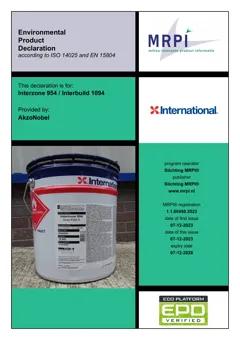

Other manufacturers with similar products
EPD: Two component modified epoxy coatings, 1.13 kg/m2, Interzone 954 / Interbuild 1094, AkzoNobel
Choose Interzone 954 / Interbuild 1094 for superior protection against corrosion and chemicals. With exceptional adhesion and durability, this innovative epoxy coating is perfect for a variety of applications. Trust it to extend the lifespan of your surfaces.
Two component modified epoxy coatings offer excellent corrosion protection, chemical resistance, and a glossy finish. Easy to apply, they provide a durable surface that can withstand harsh environments, ensuring long-lasting performance.
Mix ...
Manufacturer:
AkzoNobel
Group:
Country of production:
Product name:
Two component modified epoxy coatings
Commercial names:
Interzone 954 / Interbuild 1094
Category:
Coatings and pastes
Class:
Resins
Type:
Resins
Environmental impacts
Global Warming Potential (A1-A3):
3.65 kg CO2e/m²
Technical specification:
1.13 kg/m²
Available units for calculation:
m², kg, ton
Unique identifier (OCLID):
65bffc5386a96468ff2077b6
Sustainability data background information
EPD number:
1.1.00459.2023
EPD program:
MRPI
Publication year:
2023
Product Category Rules (PCR):
EN 15804:2012+A2:2019
Environmental standard:
EN15804+A2
Data source:
EPD Interzone 954 / Interbuild 1094
Verification status:
Third-party verified (as per ISO 14025)
Upstream database:
ecoinvent



